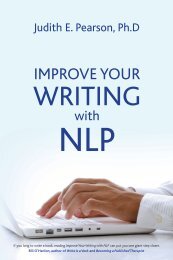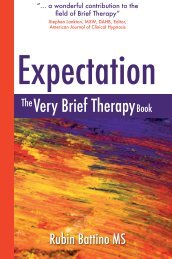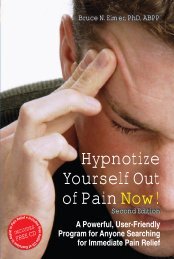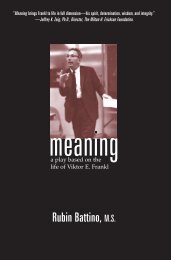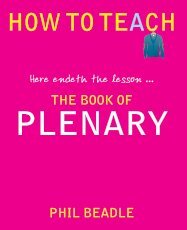Nigel Holt and Rob Lewis - Crown House Publishing.
Nigel Holt and Rob Lewis - Crown House Publishing.
Nigel Holt and Rob Lewis - Crown House Publishing.
You also want an ePaper? Increase the reach of your titles
YUMPU automatically turns print PDFs into web optimized ePapers that Google loves.
16 | A2 PSYCHOLOGY: THE STUDENT’S TEXTBOOKa notice board or newspaper advertisement may beused to ask for volunteers to respond.Generalisability <strong>and</strong> biasThe findings of the research may lack generalisabilitybecause a volunteer sample may consistof mostly helpful, interested, more motivated orobedient people <strong>and</strong> as such it may not be like thegeneral population. In addition to this a volunteersample may be open to bias as those who take partmay do so in order to seem helpful <strong>and</strong> so pleasethe researcher – who is often their psychology lecturer,<strong>and</strong> who therefore has the power to providegood marks on their work!Issues of reliabilityReliability refers to how well the research can bereplicated at another time, or if two researcherscarried out observations how well their opinions ofwhat was observed agree. In short, reliability refersto the consistency of the research. As reliabilityincreases so does our confidence in the results.Observer reliabilityA widely used method <strong>and</strong> technique in psychologicalresearch is observation. Here the researchersobserve behaviour, marking down what theysee. Often they are looking for particular types orcategories of behaviour. For example, researchersmay be interested in investigating whether malechildren behave more aggressively at play whensurrounded by other males or when in a mixedmale/female environment. In this case researcherswould observe the behaviour of males in a maleonlyplay environment, recording the number oftimes they saw aggressive behaviour. They wouldthen compare these results with similar observationsmade in a mixed male/female environment.The results of research like this will not be ofmuch use if the observations are not done in thesame way – i.e. if they are not consistent. Weneed to ensure that another person observingthe behaviour would come up with the same, orat least a very similar, result. For this reason twoobservers make observations at each session. Theirresults are compared for similarity. If the two setsof observations are similar then we can say thatthere is good observer reliability.Assessing observer reliabilityComparing the observations of two observers isbest done using correlation. This relatively simplestatistical technique allows us to see how similartwo sets of values are. A good positive correlationshows that the two observers provided similarresults. If you can show a good positive correlationto two observations of the same event then youcan say confidently that you had good observerreliability.Improving observer reliability1. TrainingIf the two observers are able to easily identify thetype of behaviours they are watching then theywill be able to record those behaviours efficiently.Practice certainly makes perfect as observation is agreat skill. Until you try it, you’ll not fully believehow fast the different behaviours come <strong>and</strong> howvaried the behaviours that might be recorded arein different situations. For this reason, carefullytraining the observers before the research beginsis advisable as a means of improving observerreliability.2. OperationalisationBoth observers have to be clear exactly what theyare looking for. For instance, if they are observing‘helping’ behaviours then they must agree whatthis means. For instance, how ‘helpful’ does abehaviour need to be before they record it as‘helpful’? If the definitions of the behaviours tobe observed are clear <strong>and</strong> carefully laid out thenobserver reliability will be better than if categoriesof behaviour are badly defined.3. View of the behavioursEach observer must have the same ability to seethe behaviours being observed. The best way todo this is to have them both base their recordingsof behaviour on exactly the same video filmof the behaviours being recorded. This ensuresthat each observer sees exactly the same things.If the observations are recorded ‘live’, perhaps bywatching behaviours in a school playground, thendifferent sight lines may mean that incidences ofa behaviour may be missed by one observer butrecorded by the other. This would weaken thecorrelation between their results, <strong>and</strong> so weakenobserver reliability.Test reliabilityVarious tests are employed in psychologicalresearch to measure behaviour. If a researcher isinterested in assessing someone’s personality thenthey can use a test carefully designed to do thejob. These tests are often in the form of questionnaires<strong>and</strong> measurement scales that require theparticipants to indicate opinions of things, <strong>and</strong>how they might respond or behave in differentsituations.Extract from A2 Psychology: The Student’s Textbook © <strong>Nigel</strong> <strong>Holt</strong> <strong>and</strong> <strong>Rob</strong> <strong>Lewis</strong> ISBN: 9781845901004 www.crownhouse.co.uk





